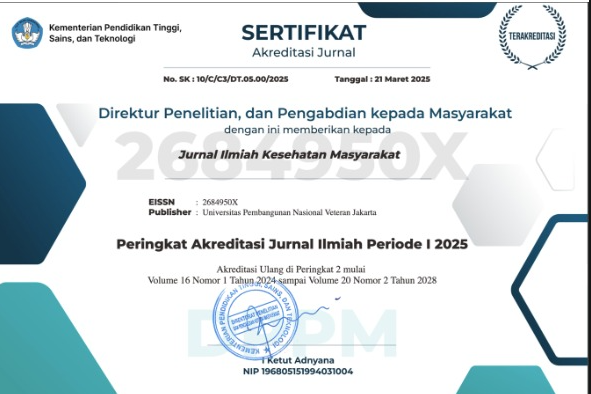The BBLR diprediksi Faktor Utama Kejadian Stunting di Provinsi Lampung: Warning untuk Ibu Bekerja dan Penerapan Pola Asuh
Abstract
Stunting apabila tidak ditangani makan akan menimbulkan dampak buruk dalam jangka pendek adalah terganggunya perkembangan otak, kecerdasan, gangguan pertumbuhan fisik, dan gangguan metabolisme dalam tubuh. (Kementrian Kesehatan RI, 2016). Diketahui analisis determinan status gizi kejadian Stunting di Wilayah Kerja UPT Puskesmas Kota Dalam Kabupaten Pesawaran. Metode penelitian menggunakan case control. Subjek penelitian adalah ibu yang memilki bayi 24 -36 bulan dengan populasi sebanyak 335 baduta dan sampel sebanyak 33 sampel kasus serta 66 sampel kontrol. Penelitian menggunakan teknik sampling systematic random sampling. Hasil dari analisis didapatkan Odds Ratio (OR) dari variabel riwayat BBLR adalah 34,261, Dalam data ini berarti riwayat BBLR yang paling besar pengaruhnya terhadap status gizi kejadian stunting. Diharapkan kepada ibu yang memiliki balita stunting dan memiliki riwayat BBLR dianjurkan menggunakan pendamping ASI (P-ASI) yang mengandung nutrisi tinggi seperti protein tinggi, vitamin tinggi, lemak tinggi, dan nutrisi yang berkaitan dengan peningkatan berat badan bayi.
LBW predicts the Main Factors of Stunting in the Province of Lampung: Warning for Working Mothers and the Implementation of Parenting
AbstractStunting ,if it is not treated will cause the bad effects in the short time is the brain development disorders , intelligence, physical growth disorders and metabolic disorders in the body. Told that the analysis of determinants of nutritional status of stunting events in UPT The Community Health Centers (Puskesmas) in Kota Dalam Area, in Pesawaran District. This research method, it is a case control. Research subjects were mothers who had babies in 24-36 months with population of 335 badutas and 33 samples to cases and 66 control samples. The research used sampling technique, the systematic random sampling. The Primary data collection techniques were by using questionnaires, the data analysis used multiple logistic regression test. The result of the analysis was gotten Odds Ratio (OR) from the history of BBLR was 34,261. In this data means the history of BBLR that the greatest effect was on the nutritional status of the stunting event. It is expected for mothers with stunting toddlers and have a history of BBLR are advised to use breastfeeding (P-ASI) which contents of high- nutrient such as high protein, high vitamin, high fat and nutrients related with the increasing the infant weight gain.
References
Kementrian kesehatan RI. PERATURAN MENTERI KESEHATAN REPUBLIK INDONESIA NOMOR 23 TAHUN 2014. 2014.
Kementrian Kesehatan RI. Buku Saku Desa dalam Penanganan Stunting. 2017.
Kementrian kesehatan RI. Keputusan Menteri Kesehatan Nomor 1995/ MENKES/SK /XII/ 2010. 2010.
Lamid. Masalah Kependekan (Stunting) Pada Anak Balita. Bogor : IPB Press. IPB Press; 2015.
Rambitan W, Purba RB, Kapantow NH, Kesehatan F, Universitas M, Manado SR, et al. HUBUNGAN ANTARA RIWAYAT PEMBERIAN ASI EKSKLUSIF DENGAN KEJADIAN STUNTING PADA ANAK BATITA DIWILAYAH KERJA PUSKESMAS KAWANGKOAN KABUPATEN MINAHASA. 2013.
Anisa P. Faktor yang berhubungan dengan kejadian stunting pada balita usia 25 - 60 bulan di kelurahan Kalibaru Depok 2012. 2012.
WHO. Child growth standards The WHO Child Growth Standards. Who. 2012;
World Health Organization. What’s at Stake Stunting Policy Brief. 2012.
United Nations Children’s Fund. The State of the World’s Children 2013. Children with Disabilities. …. 2013. 164 p.
Walker SP, Chang SM, Powell CA, Simonoff E, Grantham-Mcgregor SM. The Journal of Nutrition Community and International Nutrition Early Childhood Stunting Is Associated with Poor Psychological Functioning in Late Adolescence and Effects Are Reduced by Psychosocial Stimulation 1,2. Vol. 137, J. Nutr. 2007.
Stewart CP, Iannotti L, Dewey KG MK& OAC. Childhood Stunting : Context , Causes and Consequences WHO Conceptual framework. Vol. 9, Maternal and Child Nutrition. 2013.
Dewey KG, Begum K. Long-term consequences of stunting in early life. Matern Child Nutr. 2011 Oct;7 Suppl 3:5–18.
Abuya BA, Ciera J, Kimani-Murage E. Effect of mother’s education on child’s nutritional status in the slums of Nairobi. BMC Pediatr. 2012;
World Health Organization. Reducing stunting in children: equity considerations for achieving the global targets 2025. Who. 2018.
Aryastami NK, Shankar A, Kusumawardani N, Besral B, Jahari AB, Achadi E. Low birth weight was the most dominant predictor associated with stunting among children aged 12–23 months in Indonesia. BMC Nutr. 2017;
Checkley W, Buckley G, Gilman RH, Assis AM, Guerrant RL, Morris SS, et al. Multi-country analysis of the effects of diarrhoea on childhood stunting. Int J Epidemiol. 2008;
Lestari ED, Hasanah F, Nugroho NA. Correlation between non-exclusive breastfeeding and low birth weight to stunting in children. Paediatr Indones. 2018;
Chaparro C, Oot L, Sethuraman K, Vietnam Timor Leste B. Overview of the Nutrition Situation in Seven Countries in Southeast Asia Overview of the Nutrition Situation in Seven Countries in Southeast Asia iii. 2014.
Handayani F, Siagian A, Aritonang EY. Children of Age 24 to 59 Months in North Sumatera Province of Indonesia. IOSR J Humanit Soc Sci. 2017;22(6).
Kamiya Y, Nomura M, Ogino H, Yoshikawa K, Siengsounthone L, Xangsayarath P. Mothers’ autonomy and childhood stunting: Evidence from semi- urban communities in Lao PDR. BMC Womens Health. 2018;









.jpg)








